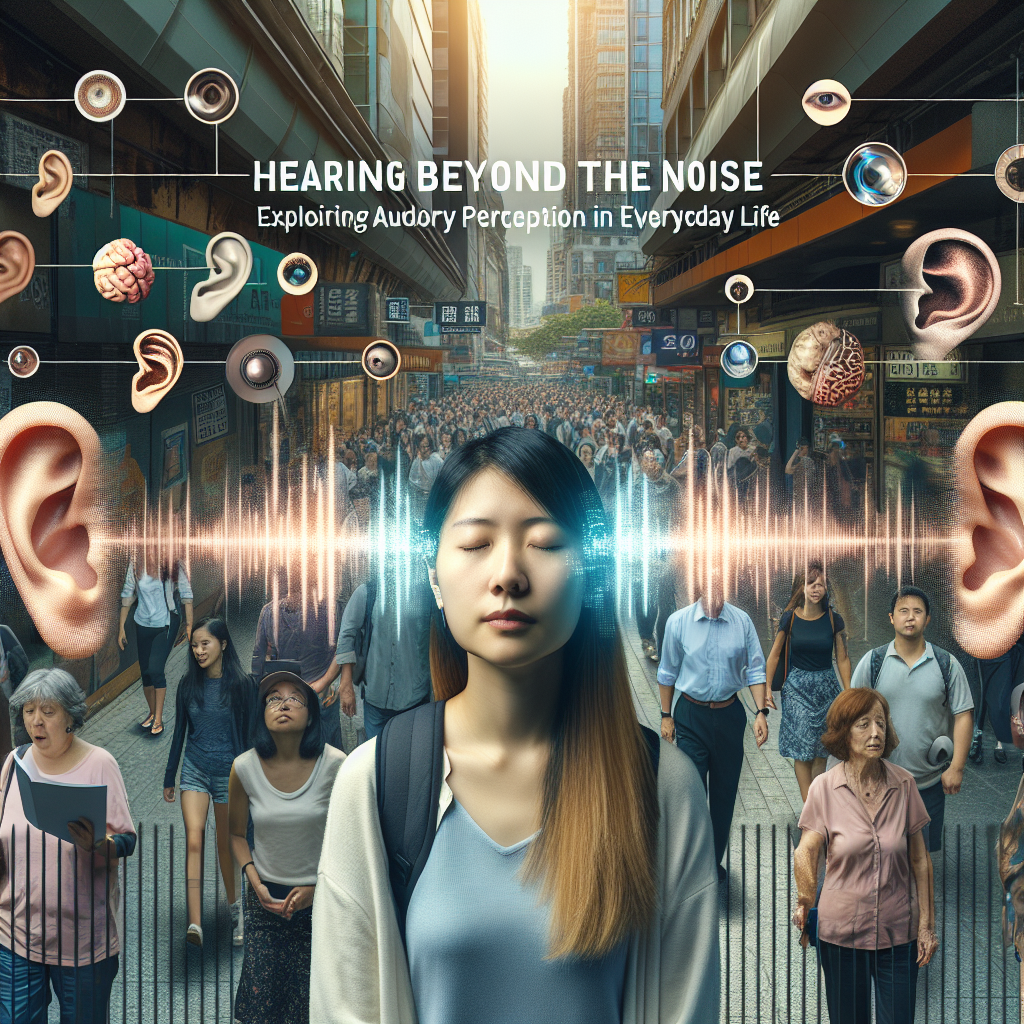
Introduction
In a world bombarded with incessant sounds—from the gentle rustle of leaves to the blaring horns of city traffic—our auditory perception plays an essential role in how we experience and interpret our environments. Hearing Beyond the Noise: Exploring Auditory Perception in Everyday Life dives into this fascinating realm, uncovering how we process sound and how it influences our daily experiences. The ability to distinguish meaningful sounds from background noise isn’t just a matter of hearing; it’s about understanding and navigating the intricacies of our auditory landscape.
The Science of Sound
Understanding Sound Waves
At its core, sound is a vibration that travels through air, water, or solid materials in the form of waves. These waves are characterized by their frequency (the pitch) and amplitude (the loudness). Humans typically hear sounds within the frequency range of 20 Hz to 20,000 Hz. However, our sensitivity to different frequencies changes with age, which can affect our overall auditory perception.
Table 1: Human Hearing Range
| Frequency (Hz) | Sound Type | Description |
|---|---|---|
| 20 – 20,000 | Audible Sounds | Normal human hearing range |
| 20 – 500 | Bass Sounds | Low-frequency sounds |
| 500 – 2000 | Mid-range Sounds | Vocals and most musical tones |
| 2000 – 20,000 | Treble Sounds | High-pitched sounds |
The Auditory Pathway
Once sound waves enter the ear, they are transformed into electrical signals that the brain interprets as sound. This journey through the outer ear, middle ear, and inner ear plays a crucial role in how we perceive auditory stimuli.
- Outer Ear: Collects sound and channels it to the eardrum.
- Middle Ear: Amplifies sound vibrations using three small bones (ossicles).
- Inner Ear: Converts vibrations into electrical signals in the cochlea, sending them to the brain via the auditory nerve.
The Role of Context in Auditory Perception
Sounds in Different Contexts
Our interpretation of sounds is heavily influenced by context. For example, the same sound may evoke different emotions or reactions depending on the setting.
- Cafés: The ambiance generated by background chatter can enhance social interactions.
- Classrooms: A quiet environment fosters learning, while distracting sounds can hinder the educational process.
Case Study: The Café Experience
Research shows that background noise in cafés can improve creativity and facilitate socialization. A study published in the Journal of Consumer Research found participants in moderately noisy environments performed better on creative tasks than those in complete silence or very loud settings. This underscores the concept of Hearing Beyond the Noise: Exploring Auditory Perception in Everyday Life, as it highlights the nuanced role of sound in fostering creativity.
Sound Localization
One of the fascinating aspects of auditory perception is our ability to localize sounds. The human brain uses cues such as time differences and sound intensity to determine where a sound is coming from. This skill is vital for navigating complex environments, enhancing safety, and facilitating social interaction.
The Impact of Noise Pollution
Understanding Noise Pollution
Noise pollution—a pervasive issue in urban environments—can have detrimental effects on our health and well-being. Chronic exposure to high levels of noise has been linked to increased stress levels, sleep disturbances, and even cardiovascular issues.
Table 2: Common Sources of Noise Pollution
| Source | Sound Level (dB) | Impact on Health |
|---|---|---|
| Traffic | 70 – 85 | Stress and sleep disruption |
| Construction | 90 – 100 | Hearing loss |
| Loud music | 100 – 120 | Permanent hearing damage |
Coping with Noise Pollution
In today’s fast-paced environment, finding strategies to cope with noise pollution is crucial. Techniques such as mindful listening, sound masking, and the use of earplugs can help mitigate its effects, allowing us to hear beyond the noise and focus on what truly matters.
Case Study: Mindful Listening Practices
A study by the American Psychological Association explored the effects of mindfulness-based interventions on auditory perception among participants exposed to urban noise. Results showed that those who practiced mindful listening reported heightened awareness and reduced anxiety levels, demonstrating the powerful connection between conscious sound engagement and improved well-being.
Enhancing Auditory Perception
Training Your Ears
Just like any other sensory skill, auditory perception can be honed through practice. Various auditory training exercises can help improve sound discrimination, localization, and comprehension, which are essential skills in crowded or noisy environments.
Exercises for Auditory Training
- Sound Discrimination: Listen to different musical notes and identify them.
- Sound Localization: Close your eyes and try to pinpoint the direction of various sounds.
- Listening to Nature: Spend time in a quiet area and identify the different sounds of nature.
The Power of Music
Music has a profound effect on our auditory perception. Studies have shown that listening to music can enhance cognitive functions, improve memory, and even increase emotional resilience. The act of engaging with music allows individuals to explore the complexities of sound, thereby heightening their overall auditory awareness.
Case Study: Music and Cognitive Function
A study published in Frontiers in Psychology examined the effects of background music on study habits. Participants who studied while listening to classical music scored significantly higher on retention tests than those who studied in silence. This highlights how Hearing Beyond the Noise: Exploring Auditory Perception in Everyday Life can lead to tangible benefits for learning.
The Future of Auditory Perception
Technology’s Role
In the digital age, technology is reshaping our auditory experiences. From noise-canceling headphones to advanced hearing aids, innovations are helping individuals enhance their auditory perceptions in multiple ways.
Innovations in Auditory Technology
- Noise-Canceling Headphones: These devices use advanced technologies to filter out background noise, providing an immersive listening experience.
- Smart Hearing Aids: Modern hearing aids are equipped with AI, allowing users to customize their listening experience based on specific environments.
The Importance of Educating the Next Generation
As our understanding of auditory perception expands, educating children about sound awareness becomes increasingly important. Schools can incorporate programs focusing on active listening, sound exploration, and appreciation of different musical genres to cultivate a generation that values and respects auditory experiences.
Conclusion
Hearing Beyond the Noise: Exploring Auditory Perception in Everyday Life is not merely about the act of hearing; it encompasses the art of listening, appreciating, and understanding our auditory world. By recognizing the significance of sound in our daily lives, we can enhance our interactions, foster creativity, and promote well-being. The journey to heightened auditory perception is ongoing and deeply personal, but the benefits are universal.
As we engage with our environment and those around us, let us strive to listen more intently, appreciate the symphony of life, and, ultimately, hear beyond the noise.
FAQs
1. What is auditory perception?
Auditory perception refers to the process by which we interpret and make sense of sounds. It involves the reception of sound waves, their conversion into electrical signals, and their interpretation by the brain.
2. How does noise pollution affect health?
Chronic exposure to noise pollution can lead to various health issues, including stress, sleep disturbances, and cardiovascular problems.
3. Can auditory perception be trained?
Yes, auditory perception can be enhanced through various exercises, such as sound discrimination and localization practices.
4. What role does music play in auditory perception?
Music can improve cognitive functions, enhance mood, and increase emotional resilience, contributing positively to overall auditory experiences.
5. How can I cope with noise pollution in my daily life?
Strategies like mindful listening, sound masking, and using earplugs can help individuals effectively cope with noise pollution and improve auditory focus.
By diving deeper into the intricacies of sound and enhancing our auditory skills, we can truly hear beyond the noise and enrich our everyday lives.

















